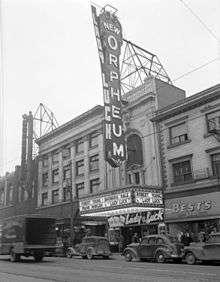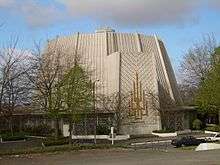B. Marcus Priteca
Benjamin Marcus Priteca FAIA (December 23, 1889 – October 1, 1971) was born in Glasgow, Scotland of Jewish heritage.[1] A theater architect, he is best known for his work for Alexander Pantages.
Benjamin Marcus Priteca | |
|---|---|
| Born | December 23, 1889 |
| Died | October 1, 1971 Seattle, Washington |
| Nationality | Scottish |
| Alma mater | University of Edinburgh in 1907 |
| Occupation | Architect |
| Awards | Fellow of the American Institute of Architects |
| Practice | Robert MacFarlane Cameron |
| Buildings | Pantages Theatre |
| Projects | Theatre architect |

According to his high school diploma, his first name was Benjamin, but on his death certificate it was recorded as "Bernard".[2] His nickname was "Benny".[3]
Education and career
Priteca served an apprenticeship in Edinburgh under architect Robert MacFarlane Cameron from 1904–1909, and during this time earned degrees from the University of Edinburgh and the Royal College of Arts.[4] He emigrated to the United States, where he settled in Seattle, Washington, in 1909.[4]
Priteca met Seattle vaudeville theatre owner Alexander Pantages in 1910 and won from him a commission to design the San Francisco Pantages Theater (1911), the first of many so-named vaudeville and motion picture houses in what would become one of the largest theater chains in North America.
In all, Priteca designed 22 theaters for Pantages and another 128 for other theater owners. Notable theaters include the Coliseum (1915) in Seattle;[3] the Pantages (1918) in Tacoma, Washington;[3] the Pantages (1920) in Los Angeles (downtown);[3] the Pantages in San Diego (1924);[3] the Pantages (renamed The Orpheum) (1926) in San Francisco (downtown);[3] the Pantages (1928) in Fresno, California;[3] the Paramount (1929) in Seattle; the Pantages (1929) in Hollywood (the last and largest of the Pantages theaters); the Warner on Pacific Boulevard in Huntington Park (1930); and the Admiral (1942) in West Seattle, and the Orpheum[5] in Vancouver, Canada.
Priteca also designed the 1934 Grandstand and Clubhouse of Longacres Racetrack in Renton, Washington, which operated from 1935–1994 and has since been demolished.
Pantages is said to have liked Priteca as a theater architect for his ability to create the appearance of opulence within a less-than-opulent budget. "Any damn fool," Pantages is quoted as saying, "Can make a place look like a million dollars by spending a million dollars, but it's not everybody who can do the same thing with half a million."
Priteca's apprentices included Gregory Ain, who went on to success as a modernist architect (practicing in a very different manner). Ain worked with Priteca for a short time in the late 1920s and helped draw the Los Angeles Pantages.[6]
In 1951, Priteca became a Fellow of the American Institute of Architects.[7] He remained active as an architect well into his eighties, working as a consultant in the design of the Seattle Opera House (1962) and the Portland, Oregon, Civic Auditorium (1968).
Priteca died in Seattle on October 1, 1971.[8] He was posthumously awarded honorary membership of the Theatre Historical Society of America.[4]
Gallery
 Terracotta Green man, Coliseum Theatre, Seattle
Terracotta Green man, Coliseum Theatre, Seattle Terracotta Griffins, Crystal Pool, Seattle
Terracotta Griffins, Crystal Pool, Seattle The Alhadeff Sanctuary of Seattle's Temple De Hirsch Sinai, a late Priteca project.
The Alhadeff Sanctuary of Seattle's Temple De Hirsch Sinai, a late Priteca project.- Civic Auditorium (now Keller Auditorium) in Portland
.jpeg) Seattle's Crystal Pool natatorium, 1916
Seattle's Crystal Pool natatorium, 1916
References
- Normand, Eugene. "A Tale of Two Cities' Jewish Architects: Emile Weil of New Orleans and B. Marcus Priteca of Seattle". academia.edu. Retrieved 2015-09-09.
- Ochsner, Jeffrey Karl (2017). "Sources of information for the architects. B. Marcus Priteca". Shaping Seattle Architecture: A Historical Guide to the Architects (2nd ed.). University of Washington Press. p. 377. ISBN 9780295806891.
- Michelson, Alan (2015). "Benjamin Marcus Priteca". Pacific Coast Architecture Database. Retrieved 2018-02-11.
- Sutermeister, Miriam (2017). "Chapter 32. B. Marcus Priteca". In Ochsner, Jeffrey Karl (ed.). Shaping Seattle Architecture: A Historical Guide to the Architects (2nd ed.). University of Washington Press. pp. 216–221. ISBN 9780295806891.
- "B. Marcus Priteca - The Orpheum Theatre - History of Vancouver". www.vancouverhistory.ca. Retrieved 2018-02-11.
- Denzer, Anthony (2008). Gregory Ain: The Modern Home as Social Commentary. Rizzoli Publications. ISBN 0-8478-3062-4.
- College of Fellows: History & Directory. The American Institute of Architects. 2000. p. 86.
- "B. Marcus Priteca". The New York Times. 4 October 1971. p. 42. Retrieved 2018-02-11.
- Biographical sketch of B. Marcus Priteca (with photographs) at Puget Sound Theatre Organ Society
- Statt, Daniel, Pantages, Alexander (1876-1936), HistoryLink.org Essay 2999, February 19, 2001, Corrected December 18, 2002. Accessed 10 March 2007.
External links
| Wikimedia Commons has media related to B. Marcus Priteca. |
- "Movie Theaters Designed by Benjamin Marcus Priteca". Cinema Treasures.
